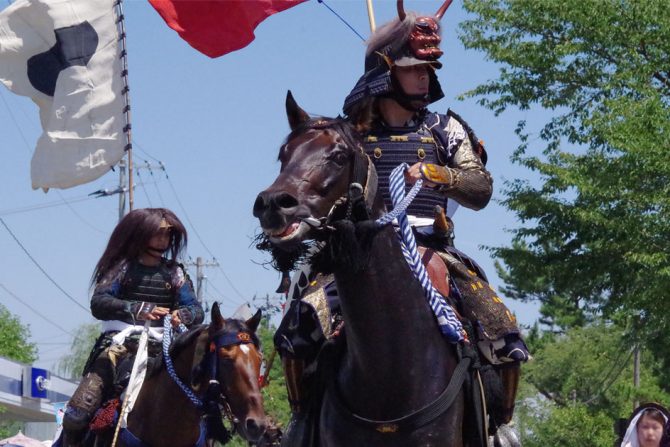
This is the very Japanese “Samurai”! A Pageant of a splendid picture scroll with tremble spirits, “Soma-noma-oi”
It is the mid-summer July 2015 when we visited South-Soma.
In 2013, Soma-shi/South-Soma-shi in the Northern Part of Fukushima prefecture along the Pacific Ocean was hit by the big earthquake, which is now called “Eastern Japan Big Earthquake Disaster”.
In spite of the disaster the Soma-noma-oi with more than a 1000-year-history which is designated to the national important intangible folk culture asset, took place.
It is a “Horse festival” of a globally and unparalleled grandeur and foreign sightseers might be very excited to see, saying “The Last Samurai!!”.
You can’t experience this astonishing power in a film. On top of that, you will really feel as if you are in a time machine.
It is not an exaggeration to say that the Kiba-mushas (a Samurai on one’s horse) who ran, cutting through the air rattling their metal armours, are like “the battling Samurai” come to life in this modern-era.
After the earthquake, the performances had been suspended for a few years, but this year it reopened for 3 days from 25th to 27th July.
The 450 Kiba-mushas and total 1,000 audiences including authorities took part in and its scale was the same as before the earthquake.
The Fukushima Trip Editors visited the site. I am introducing the atmosphere of the Soma-noma-oi which has an amazing power.
The history of Soma-noma-oi which is the biggest scaled performance in the world, with a 1000-year-tradition.
Soma-noma-oi is a traditional event from 1000 years ago in Soma-shi and South-Soma-shi located along the Pacific Ocean in Fukushima prefecture.
The origin goes back to the Kamakura-era.
Masakado Taira who was the ancestor of the Soma-family who ruled the area at that time held it as military exercises.
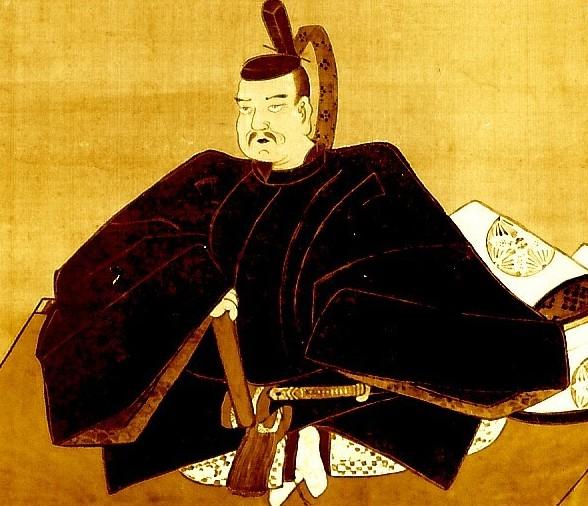
In 1952, it was designated to the national intangible folk cultural asset and it is held for 3 days in July every year since then.
It has the significance of “worship the God festival”.
The atmosphere of several hundreds of Kiba-musha is beyond description.
It is one of the Tohoku 6 Big Festivals.
It is said that it is the pioneer of the poetic charm in summer.
In the Festival, several hundreds of Kiba-mushas in their metal armour accompanied by their retainers have a procession for about 3 km to the Soma-noma-oi site.
On the Festival site, the two main events are held.
One is called “the horse racing in their armour”, to show off one’s speed.
The other one is called “the competition for the sacred flag” to get the flag on the horses.
Every year, the “General” is selected from the Soma-family descendants.
This year, the first son, Michitane Soma of the 33rd descendant, Kazutane Soma took the position. Most other people also take part in from generations past.
The horses are their loved ones or former racing horses.
In order to publicise the event, they go to Tokyo before the Festival. This year, they appeared in the Kanda Festival and the Hello Nishiogi.
In the past, they visited the 6 countries overseas such as America, England, Russia, Hawaii and Brasil!
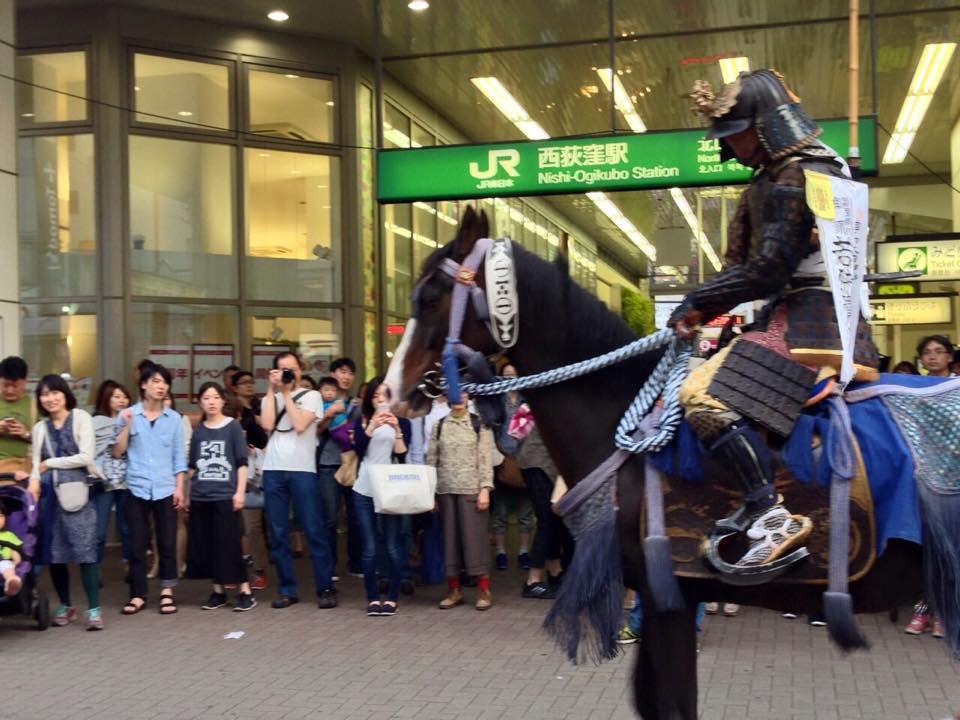
The biggest event that Soma-shi, South-Soma-shi and Fukushima are proud of draws the attention and interests of the world.
Not only male adults, but also female Kiba-mushas or even child Kiba-mushas take part in.
There are a lot of motifs of horses everywhere on the street in Soma-shi!
I am introducing you to the atmosphere on the day. (26th July)
We arrived at South-Soma-shi at 7 o’clock in the morning, because we knew that many sightseers from all over Japan had come to watch it.
When we checked the car number plates, some of them were from Kyushu or Hokkaido.
(surprise!)
The amount of people who came this year was 63,000 which was 4,000 more than last year!!
We, the Fukushima Trip Editors went to the Festival site before other people came, because we thought the route on which they have a procession would be extremely crowded.
We went to the site on foot and we saw the route of the procession was full of Soma-noma-oi
atmosphere. On the street lamps, the flags with the Soma coat of arms have been hung and the motifs of houses are everywhere.
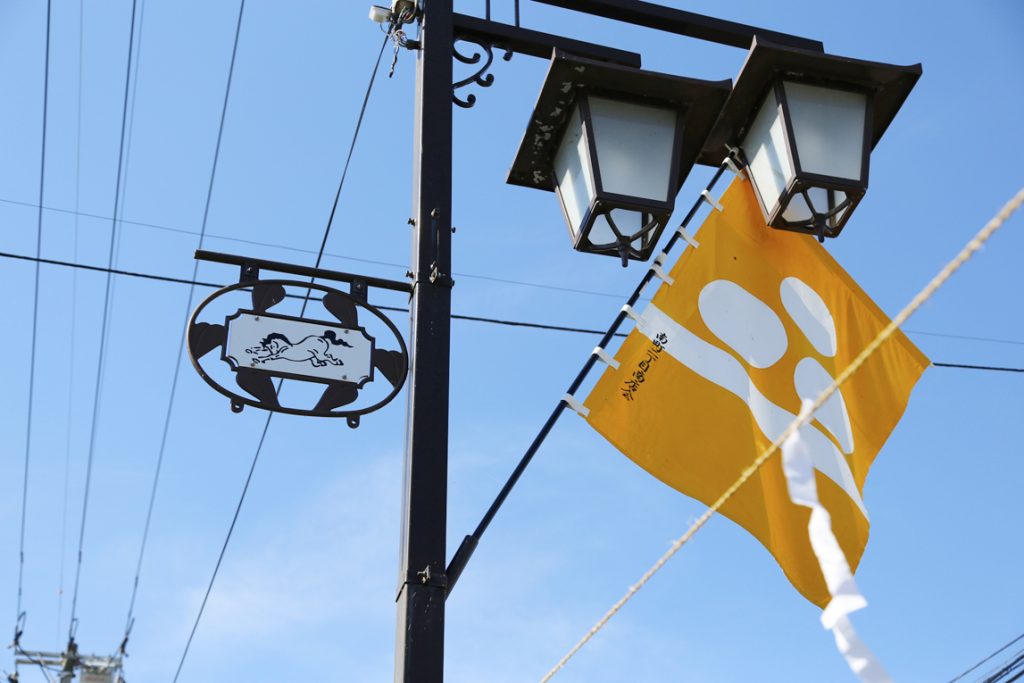
On the top of the street lamp, there is a running horse.
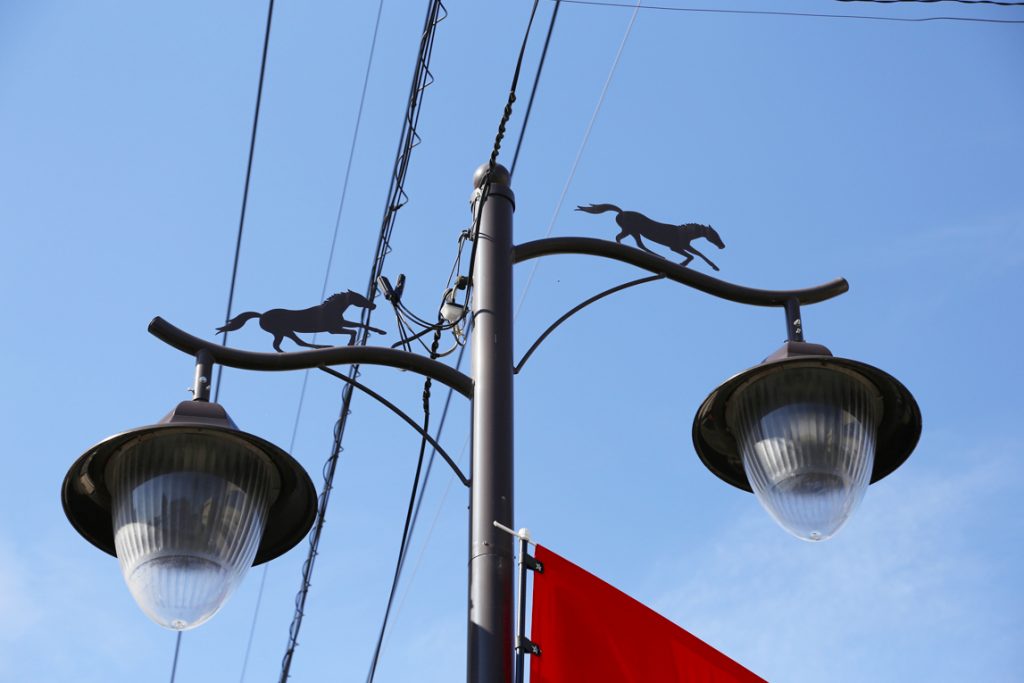
The horse is even at the gate of the parking space of the local bank!
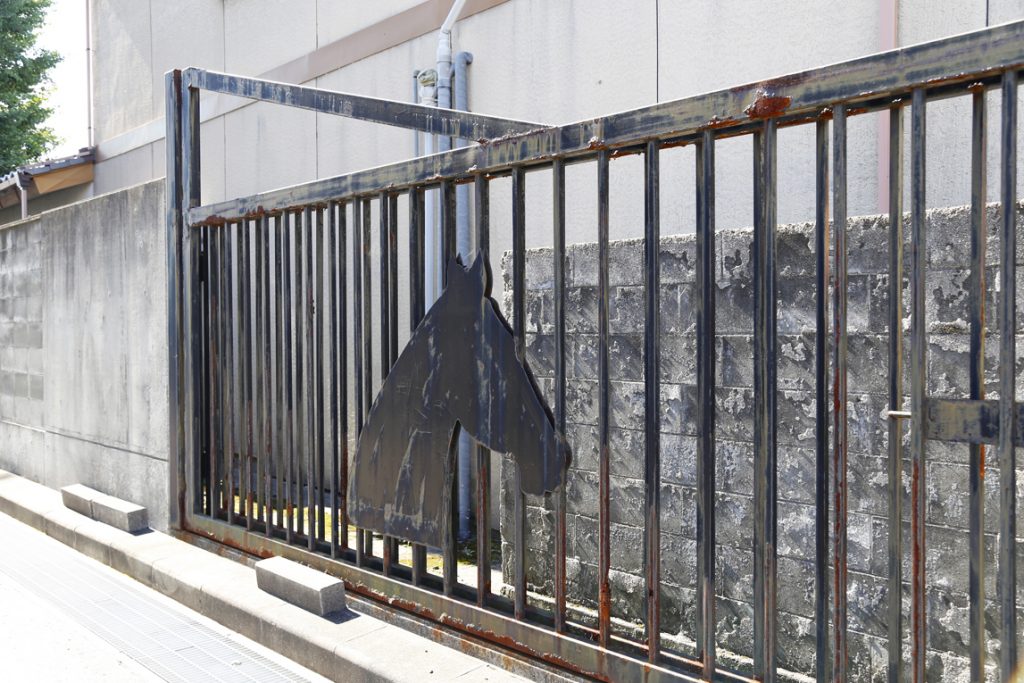
There is a plenty of time before the start of the Festival, so the Kiba-mushas made us enjoy the sight of them.
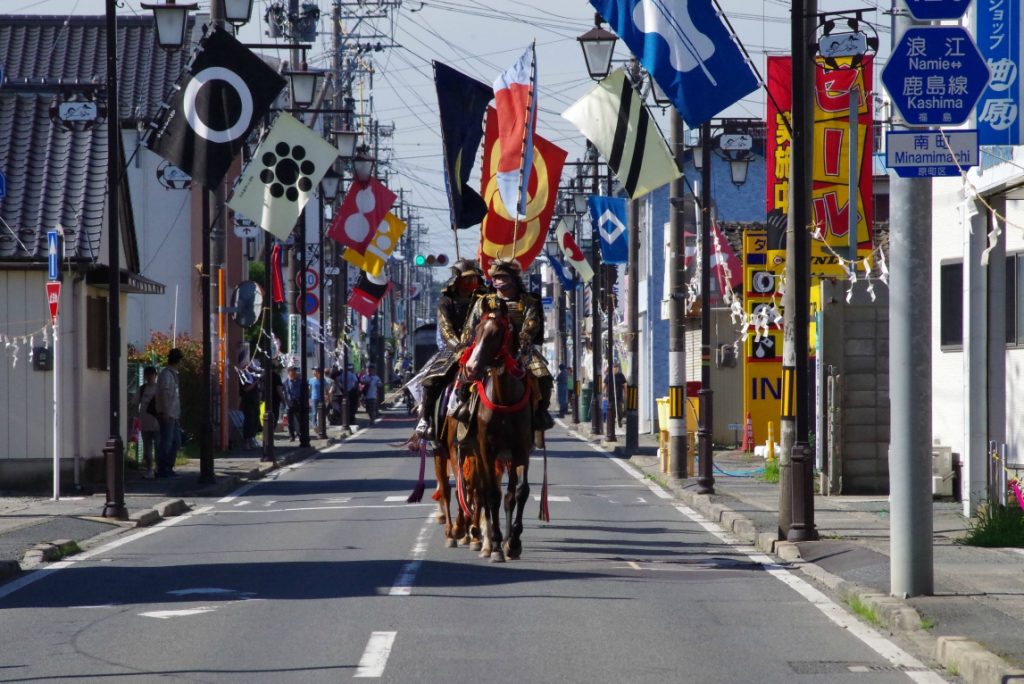
I felt as if I was in a time capsule.
The armourers looked handsome and the size of horses surprised us. (Wow!)
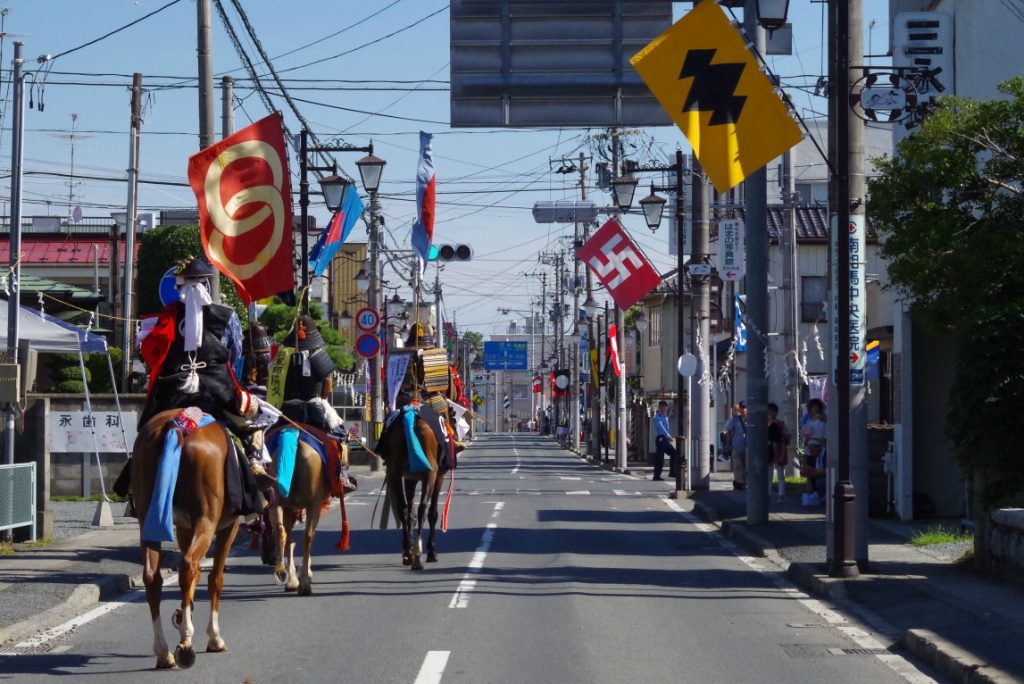
At this early time, Kiba-mushas can be seen on the street and they are happy to join our photo opportunities.
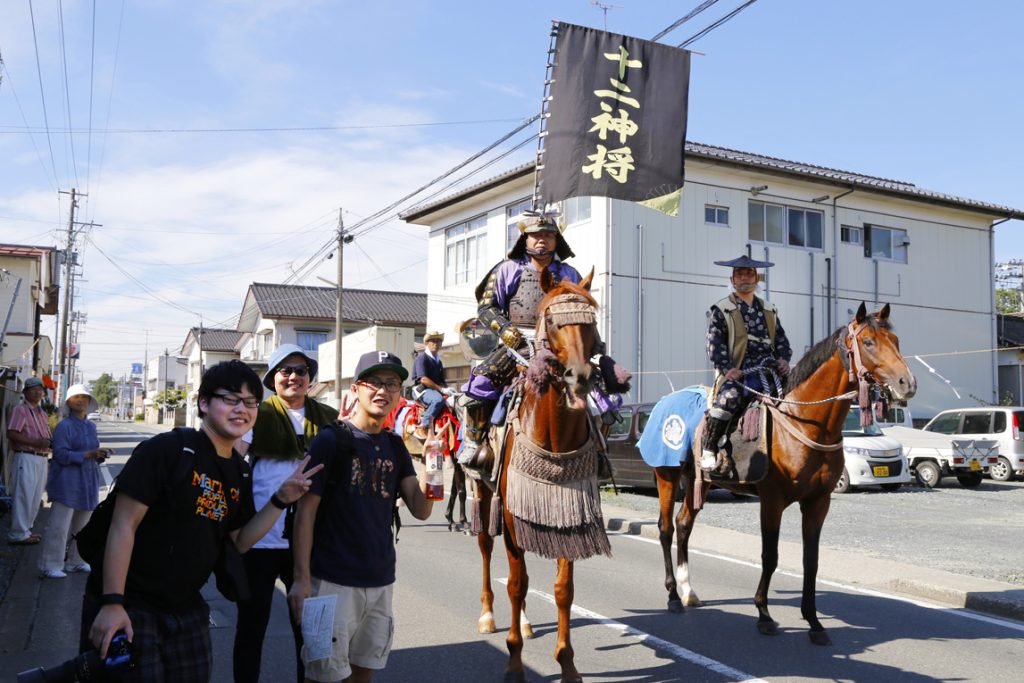
The time of the Festival to start approaches, the number of people have been increasing and some sightseers as well as photographers are already standing-by.
It will start at 9:30. We thought we had arrived too early, but it was a good choice to watch it at the best place.
The procession of the Kiba-mushas has started!!
Each Kiba-mushas are organized into the 3 troops depending on one’s origin and the shrines.
They start from the 5 old “Go” area, (Uta-go, Kita-go, Naka-no-go, Odaka-go, Shineha-go) to
The Soma-noma-oi festival site, just like the war drama.
Along the road to the site for 3 km, people were packed and they were watching the procession fully absorbed.
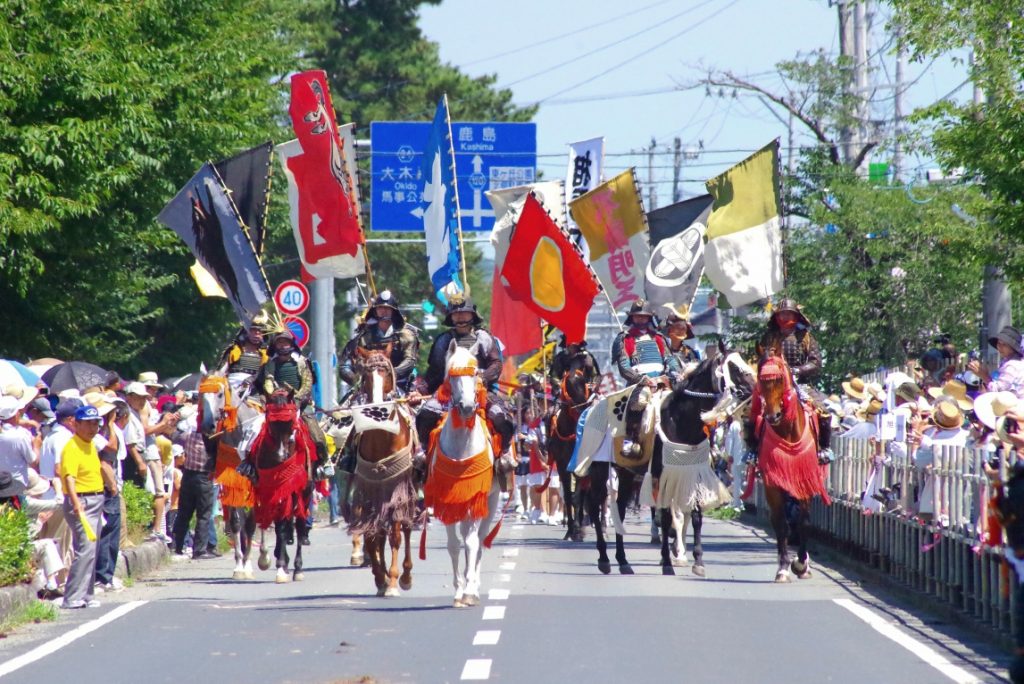
It looked like a parade with the mixture of the colourful flags with the family coat of arms and the flags that the Kiba-mushas were carrying on their backs.
The flags that the Kiba-mushas have been very precious for generations.
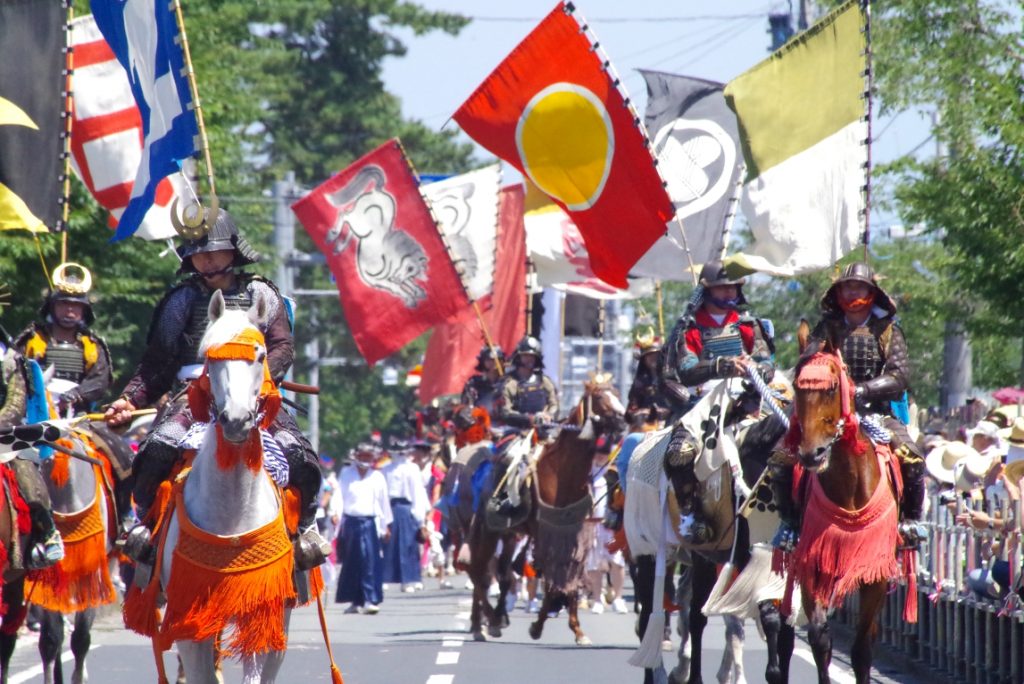
Their armours and helmets are different looking, depending on the Kiba-musha.
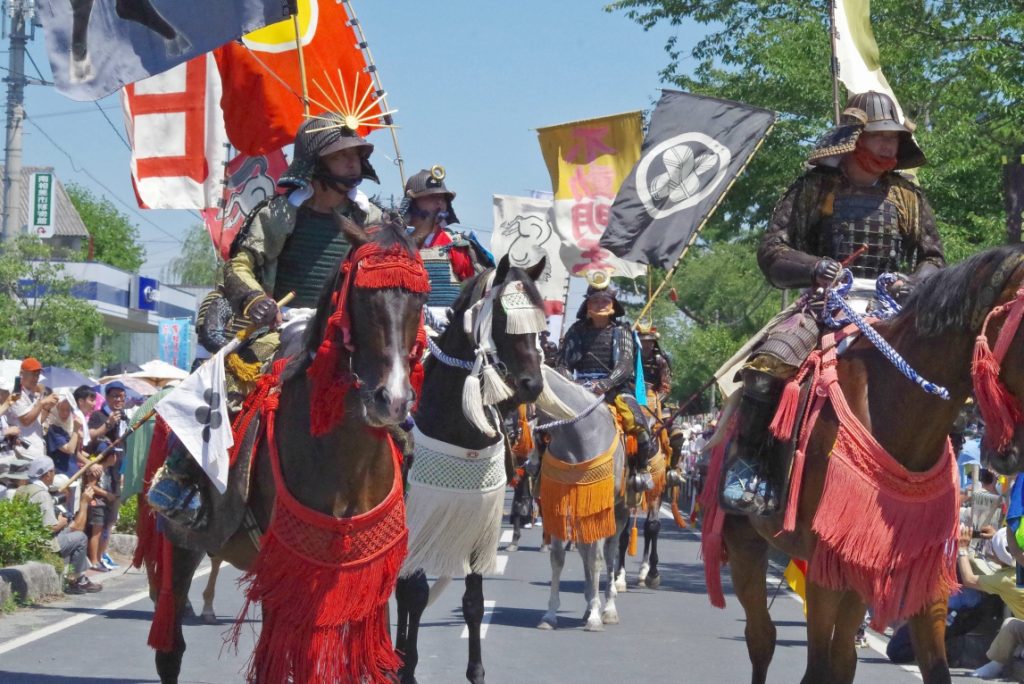
Some helmets have animals or Kanji letters on and the colours are also different.
They are very individual!
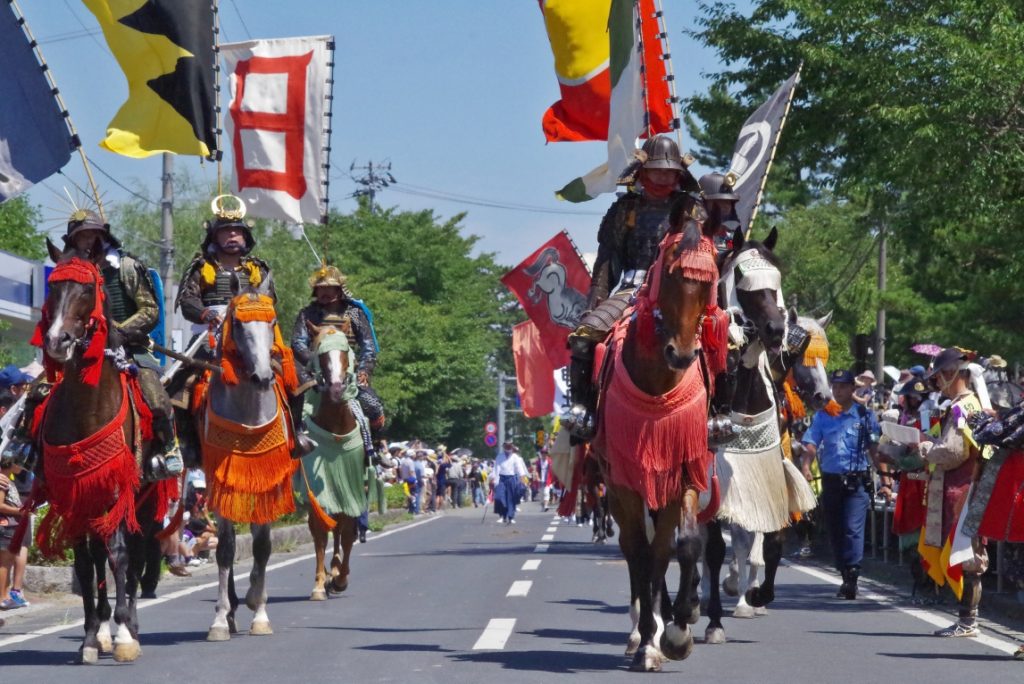
They are lovely child Kiba-mushas!
The youngest Kiba-musha is 2 years old and the oldest is 87 this year! The female Kiba-mushas are under 20 and the 17 unmarried females took part.
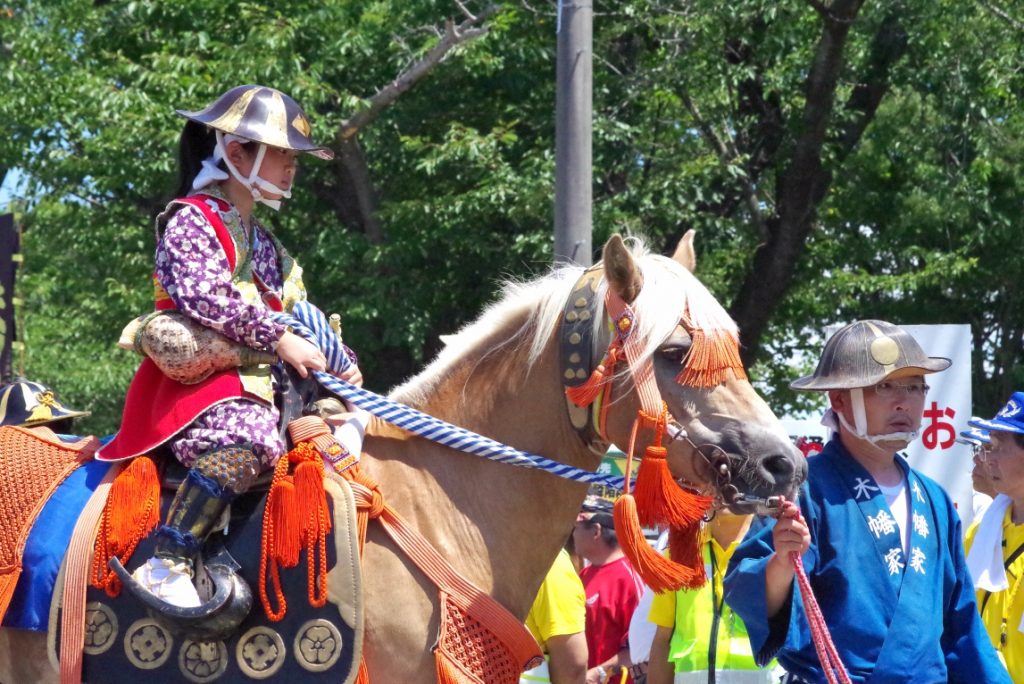
The Kiba-musha from each area entered the site one after another.
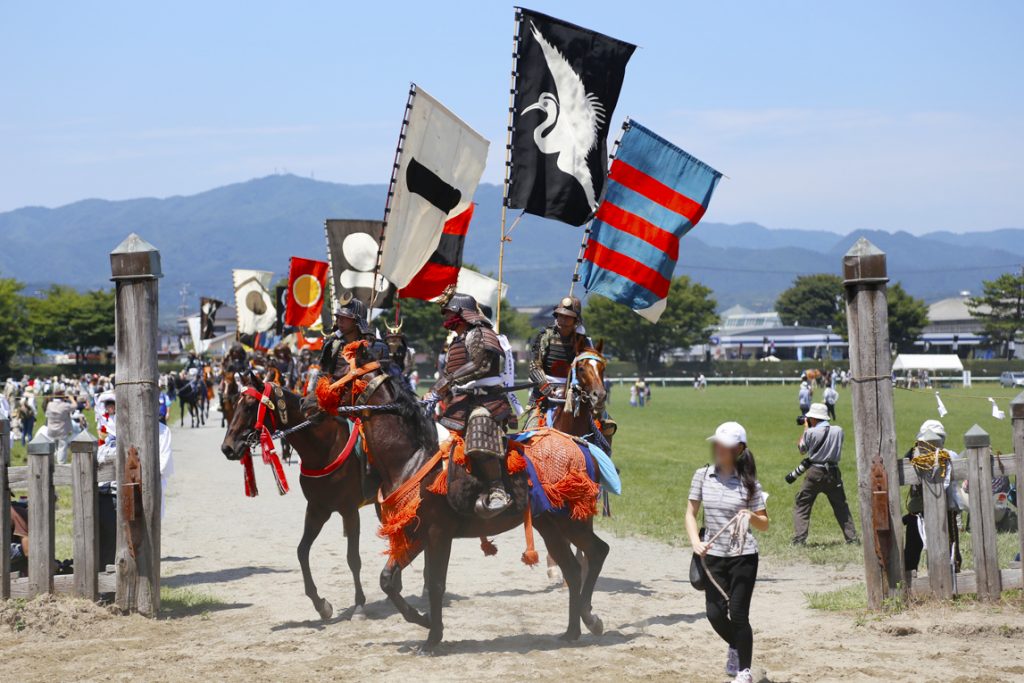
The line-up of the Kiba-mushas look cool!
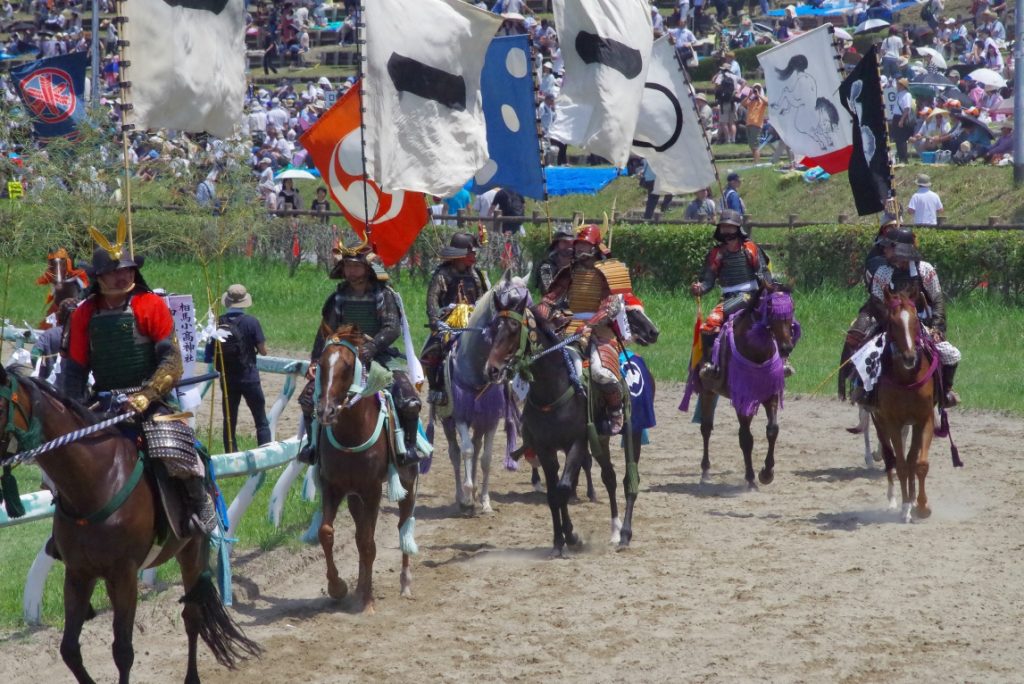
This is the General Michitane who is descended from the Soma-family. He was carrying something like a basket on his back. I learned later on that the basket was for the head of the enemy.
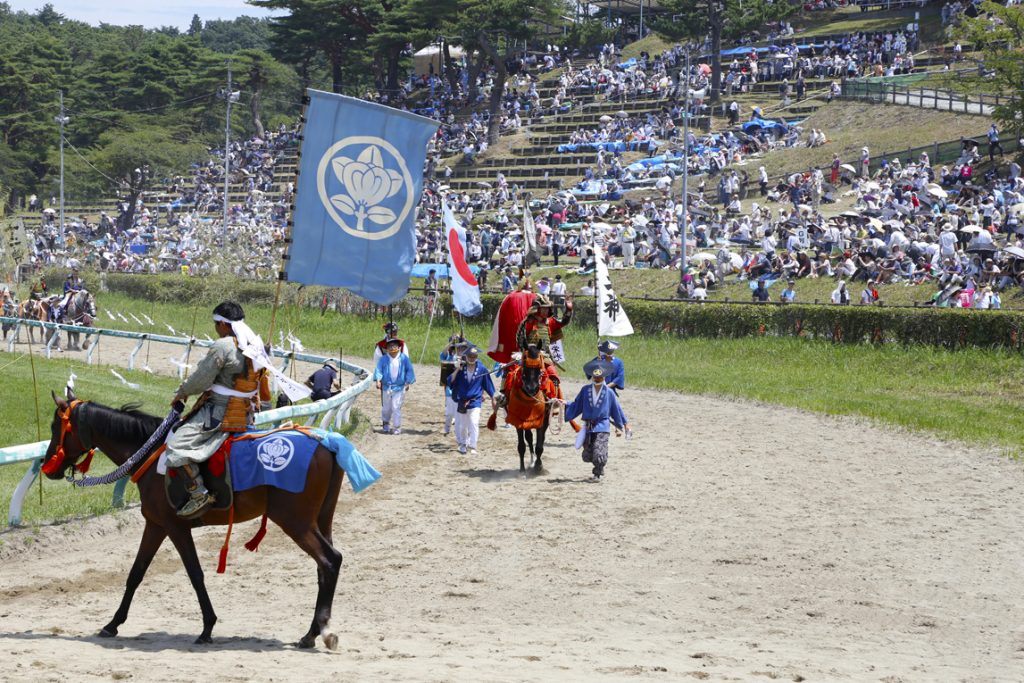
The Kiba-mushas gathered on the site one after another.
It looked as if the battle was about to start.
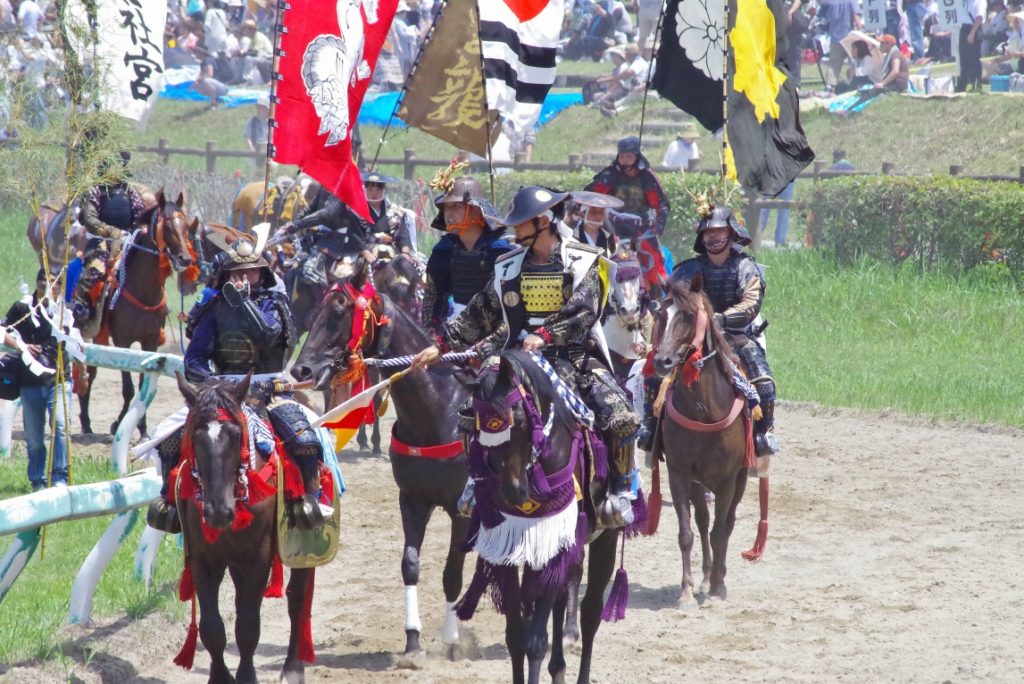
The viewing point of Soma-noma-oi! The horse racing in their armour to compete for speed now starts.
After putting the miniature shrine in the main building on the top of the mountain, one of the main events starts.
The horse racing in their armour competes among the 10 horses on the 1000m-round –course.
So many photographers and audiences gathered along the course.
Then, it finally started!!
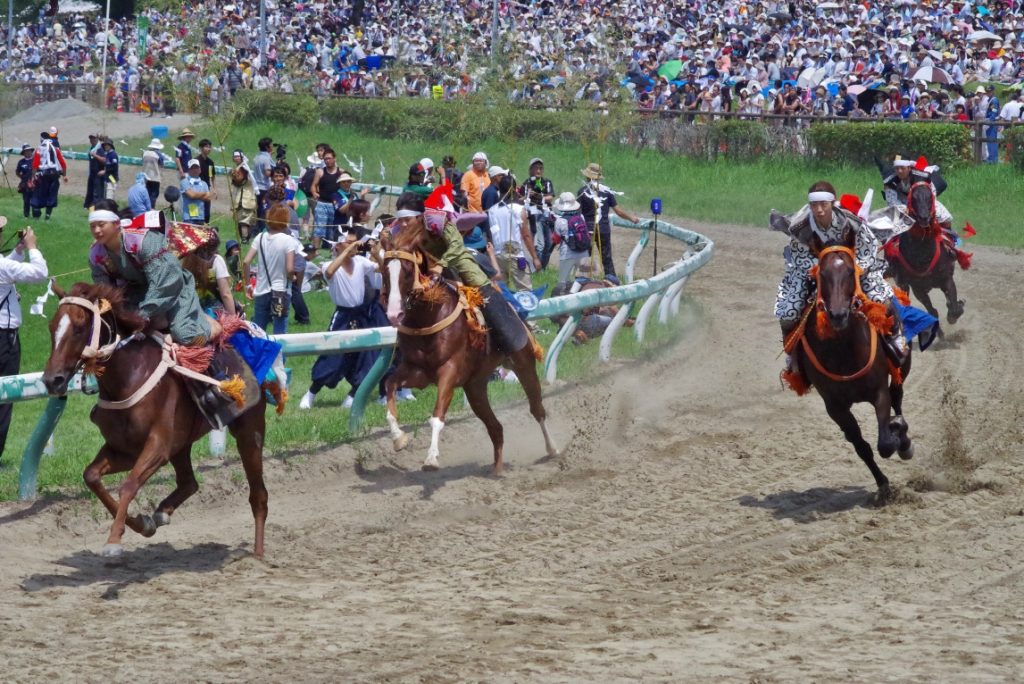
Da, da, da. With the sounds of the running horses, the dynamic performance of the Kiba-mushas with the tremendous speed was so powerful.
The sound of the flags cutting through the air is refreshing!
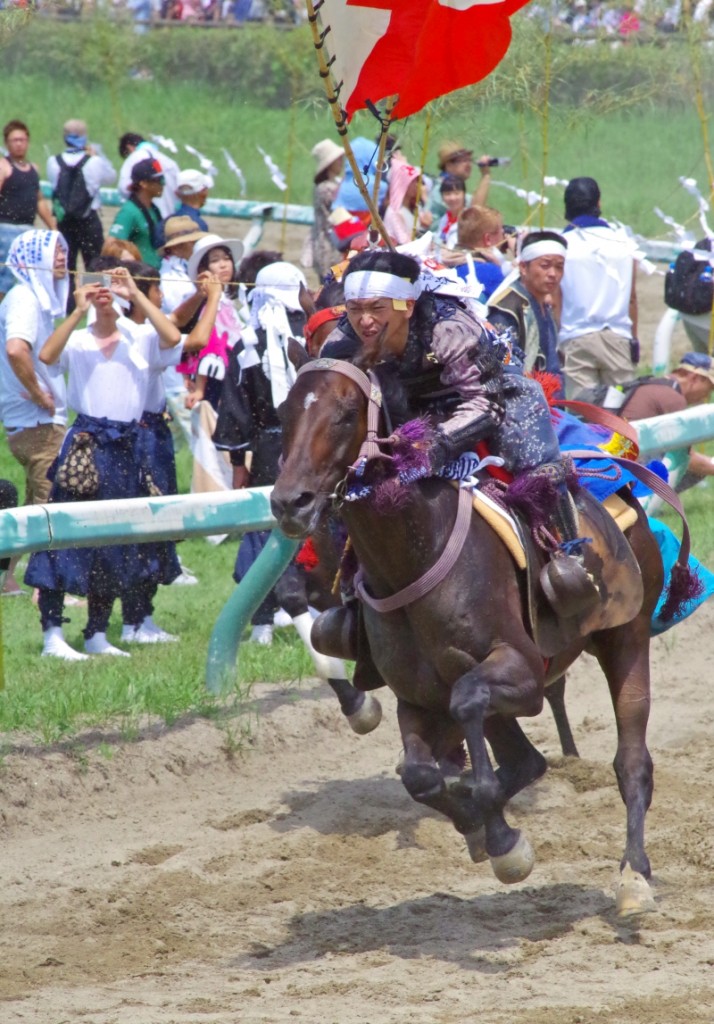
You can see the horses’ power, because of the huge amount of sand kicked up by their hoofs.
The Young-Samurai’s faces with their prestige are engraved on my mind’s eye.
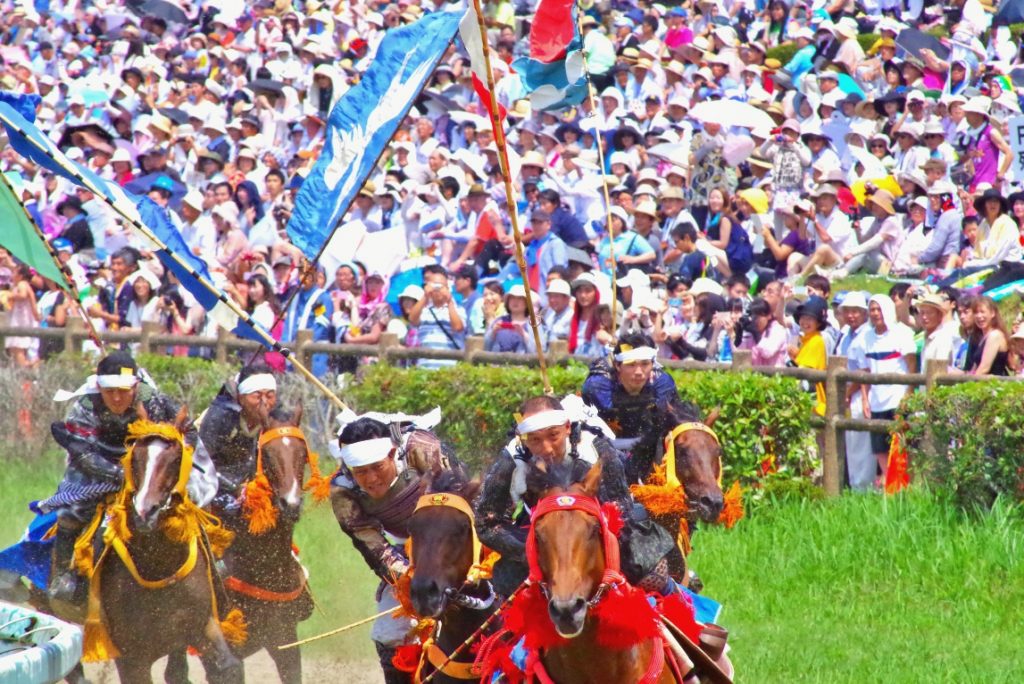
The female Kiba-mushas were among them. They showed their wonderful performances as well as the male Kiba-musha!
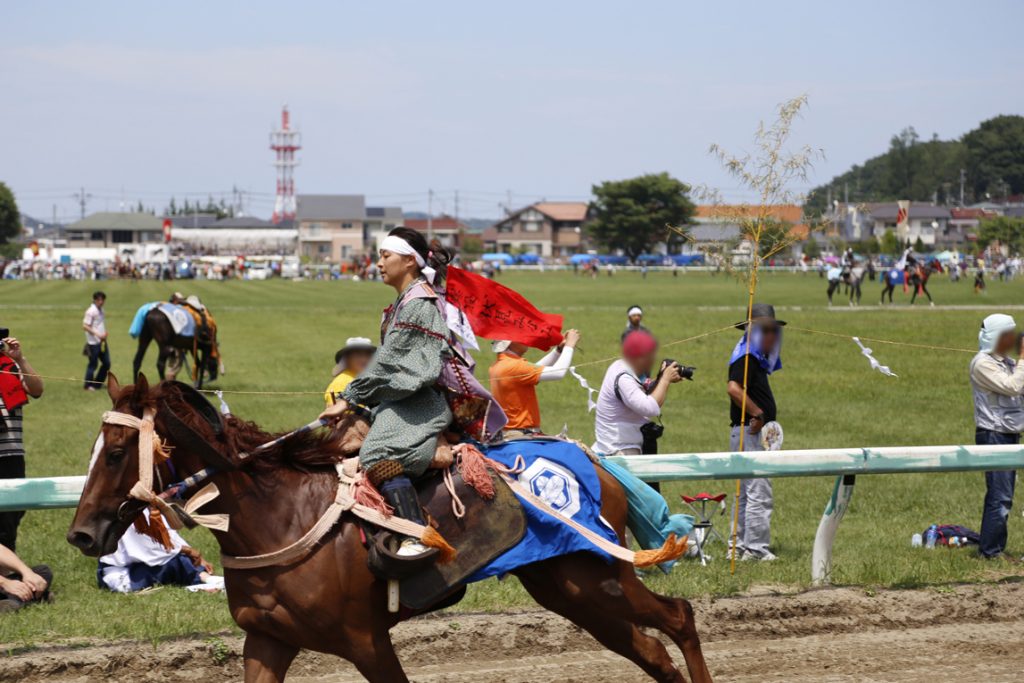
I took the film as well. You can see it here.
The final event is the competition to get the sacred flag. It just looks like a battle.
The sacred flag with the 3 colours was launched.
When it came down, all the Kiba-mushas tried to get it. The dynamism of the performance is different from the horse racing. It looks like the remained modern battle!
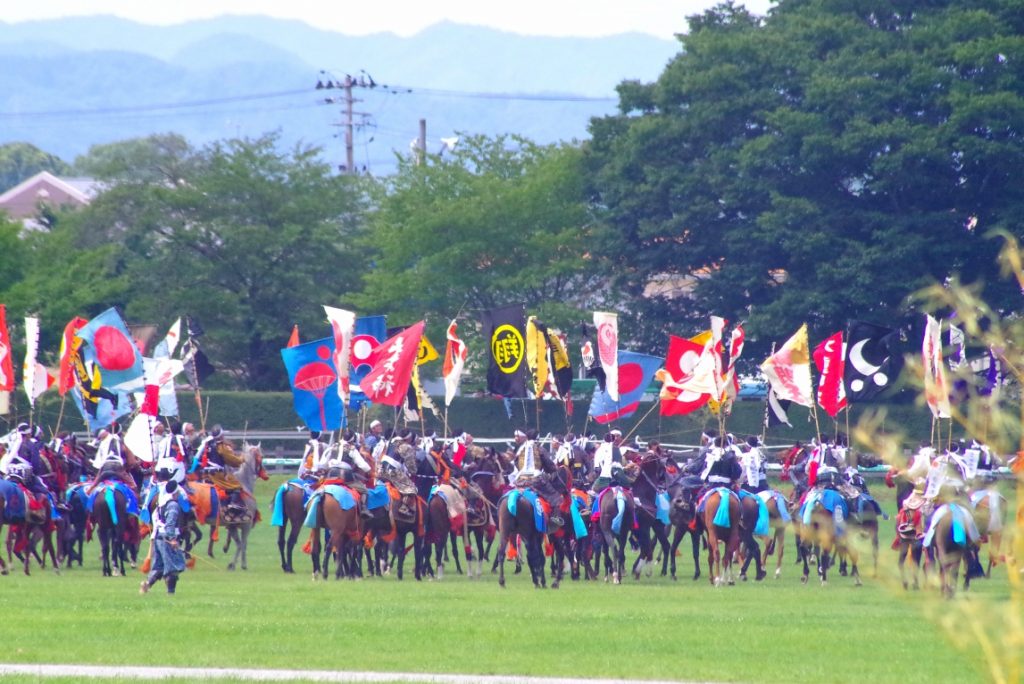
The 3 colours on the sacred flag are blue from the “Soma Nakamura Shrine”, red from the “Soma Ota Shrine” and yellow from the “Soma Odaka Shrine”.
The flag is compared to the head of the enemy.
It is a trace of the military exercise which it commemorates.
The fireworks were set off with the resounding sounds on the site.
The Kiba-mushas started to compete to get the sacred flag coming down from the sky.
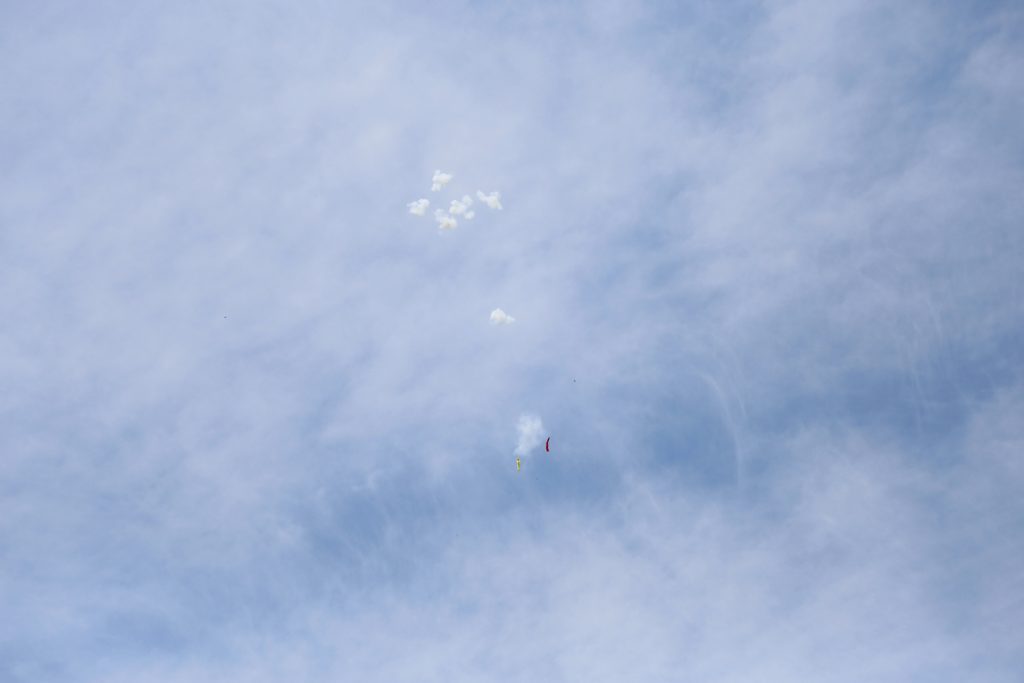
It looks like the scene from a battle film and it is happening right now in front of me!
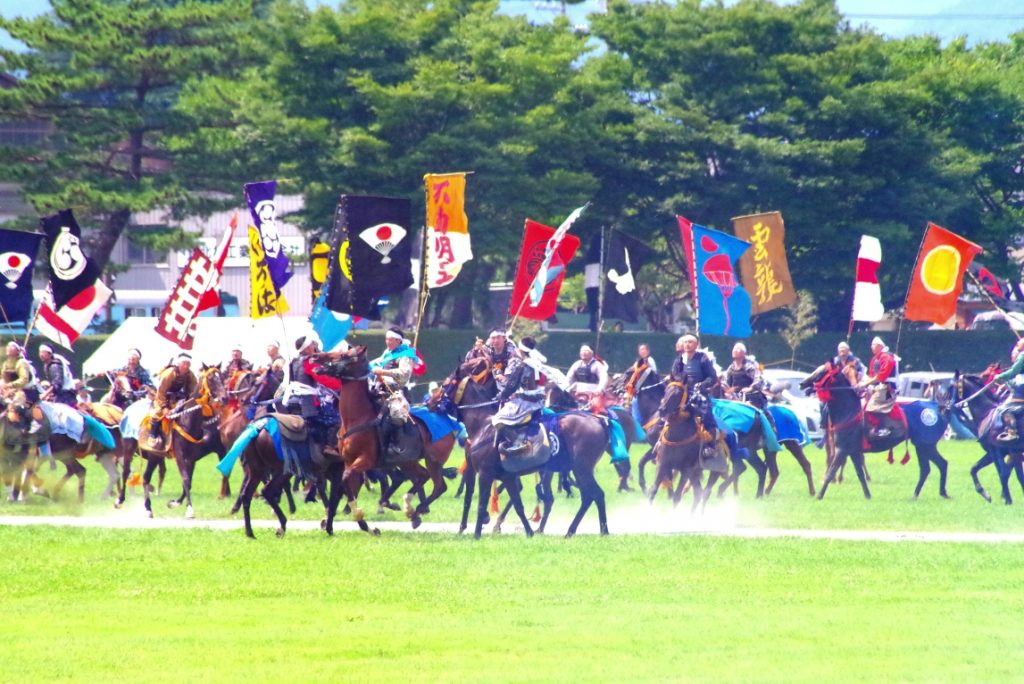
The red flag in the centre of this picture is the sacred flag. They are trying to get it.
Some Kiba-mushas fell off their horses, because of such a fierce battle.
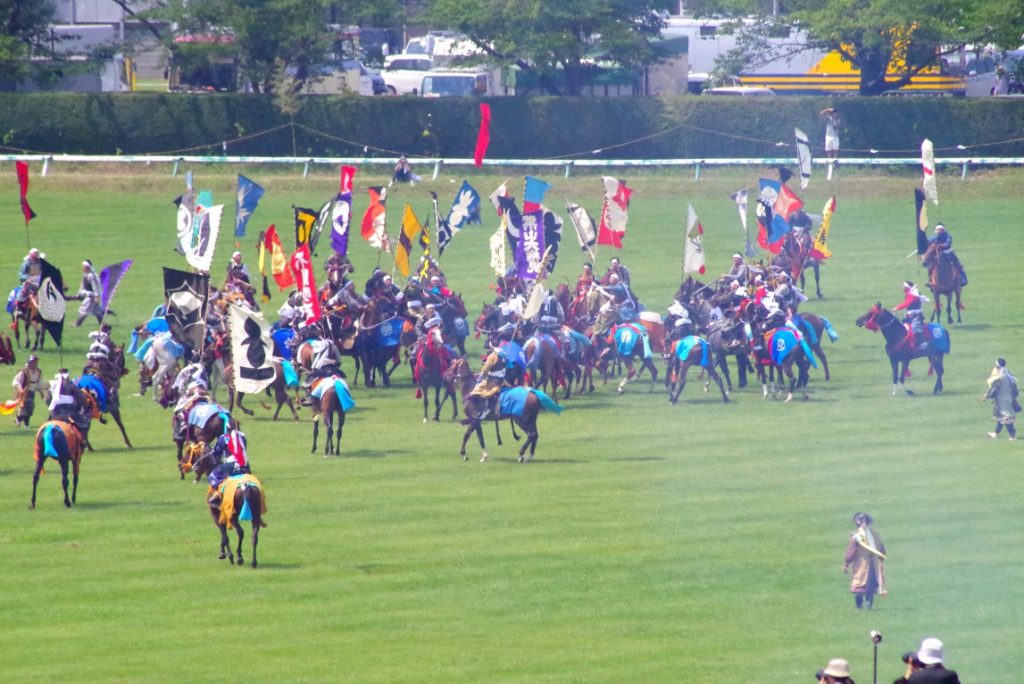
The Kiba-musha who got the sacred flag is running straight up to the mountain, flashing the flag to the top on where the main building is.
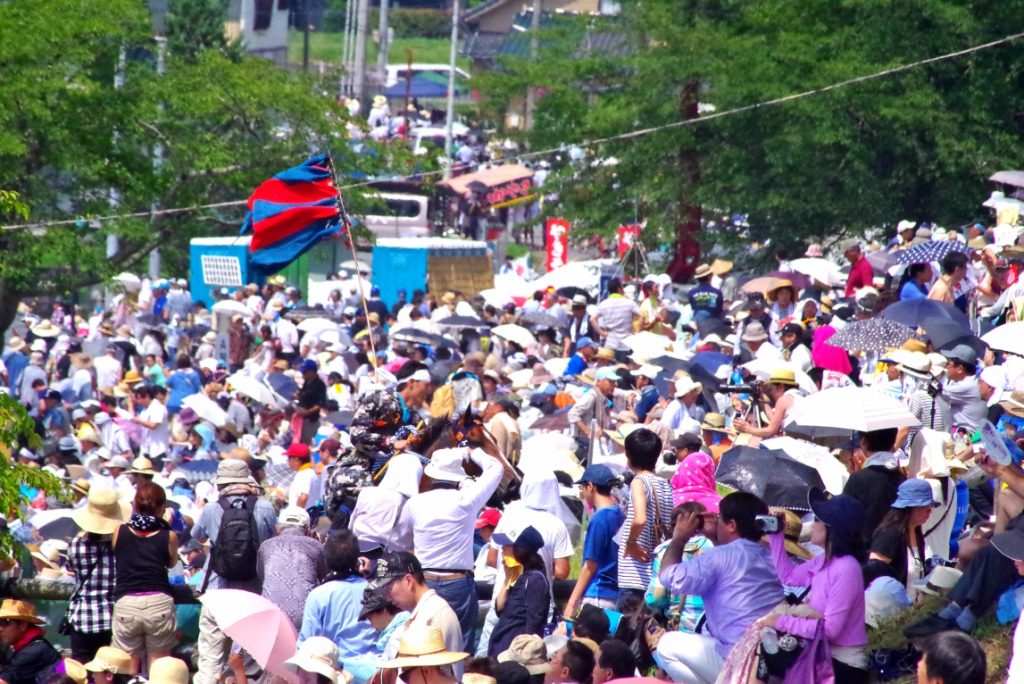
When the sacred flag was taken, the audience gave the shout of joy.
The Kiba-mushas and the audiences mingle together and this is one of the attractions of the Soma-noma-oi Festival.
The announcement was made about the happenings. It said that one Kiba-musha had forgotten his sword behind and one horse had run off without its Kiba-mush.
The audiences burst into laughter.
I kept being surprised by the tremendous scale of the performances in front of me.
The biggest festival world-side can only be seen in Fukushima.
You should see it once in your life-time!
Conclusion
The Some-noma-oi is held every year but it had been suspended for a while due to the earthquake.
However, people have been making their great effort to keep their training in early mornings in order to keep the 1000-year-traditon.
The strong intention of the Soma-people is extraordinary to hand it over from generation to generation.
We met an elderly married couple from another prefecture and they told us that they come and watch the Soma-noma-oi every year.
The couples talk with their happy faces convinced us that the Soma-peoples will attracts many people.
It might be only the Soma-noma-oi which reproduces the old martial art among any other prefectures in Japan.
We, the Fukushima Trip will support this Pageant to be recognized by many people over the world!



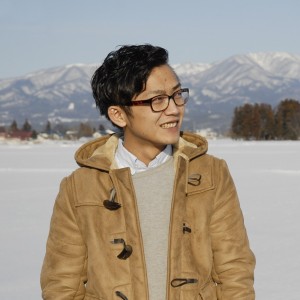
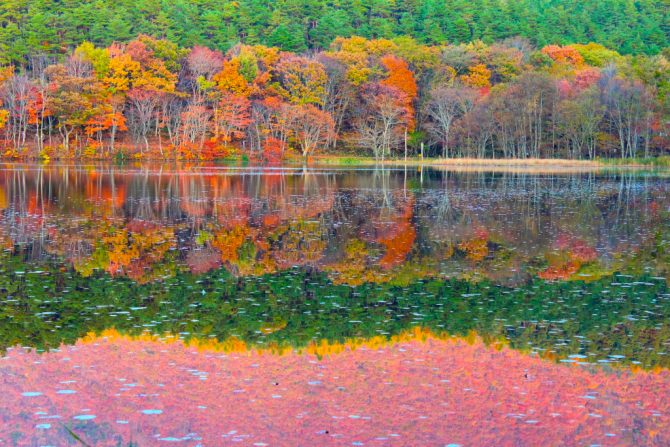
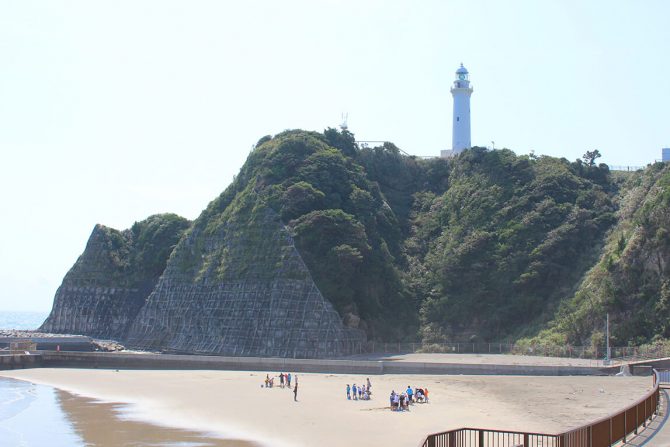
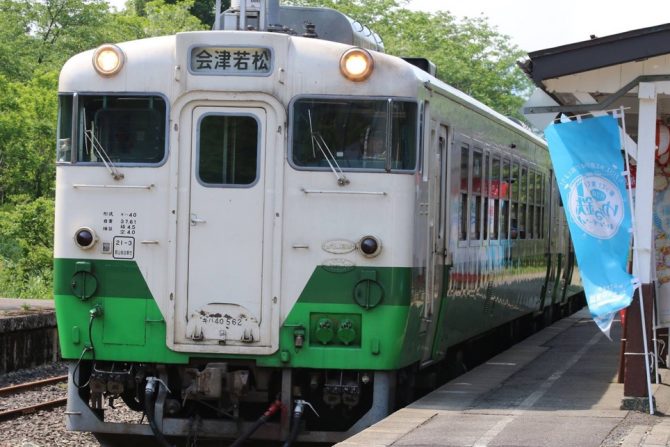
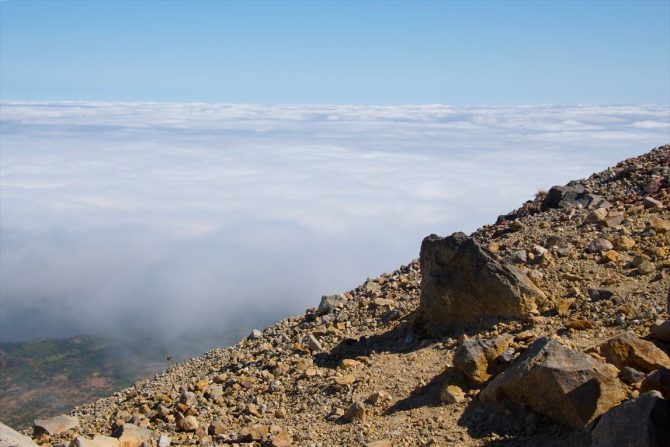
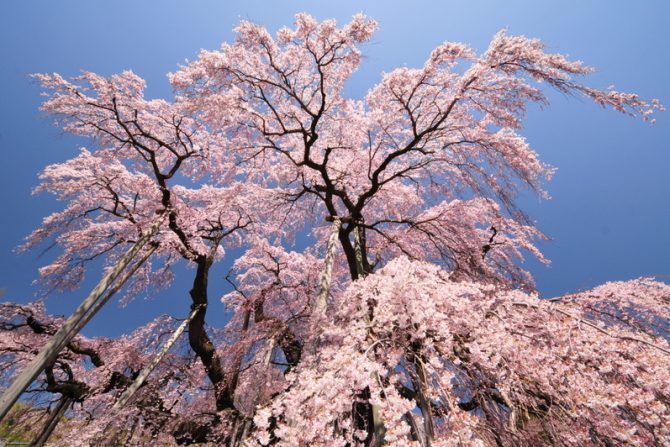
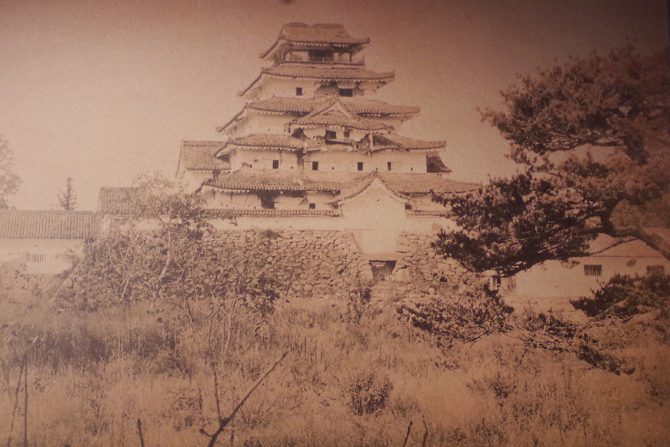
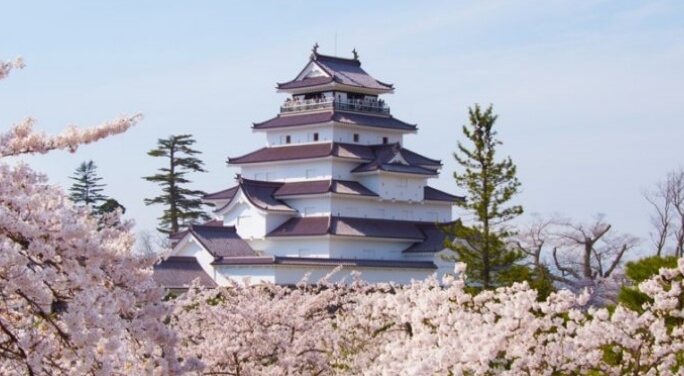
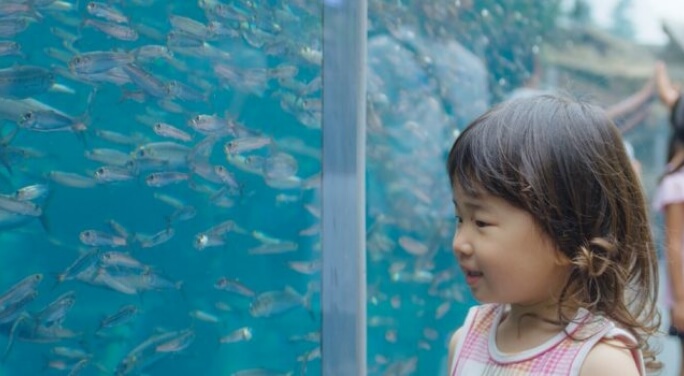
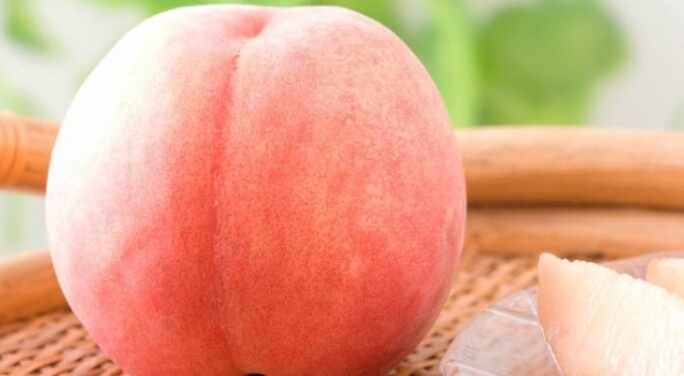
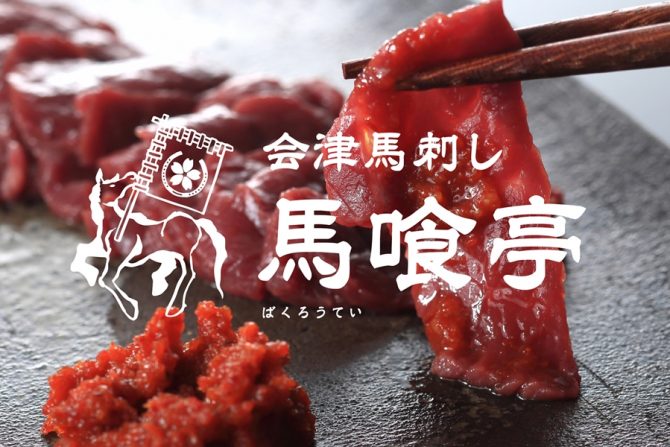
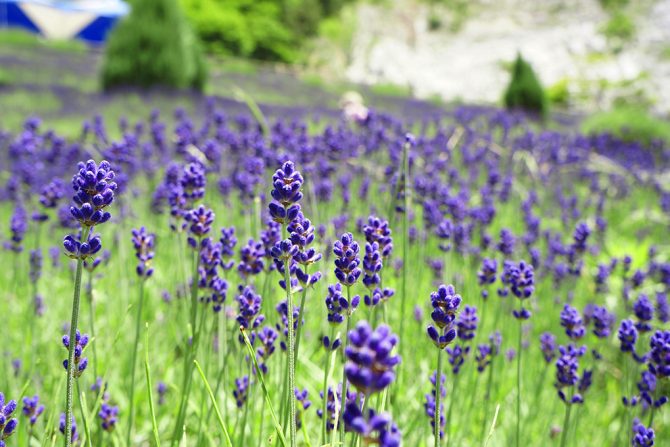
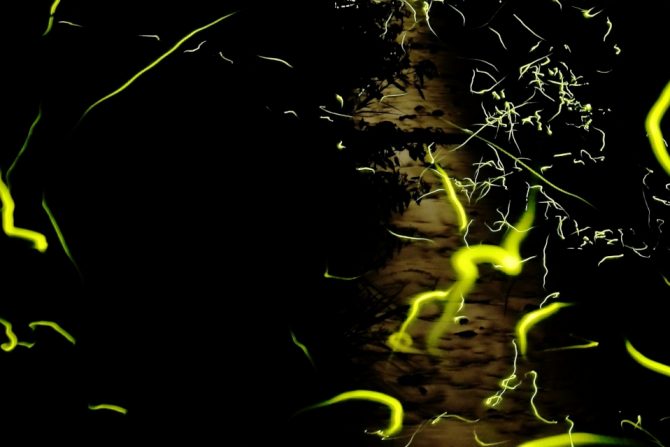
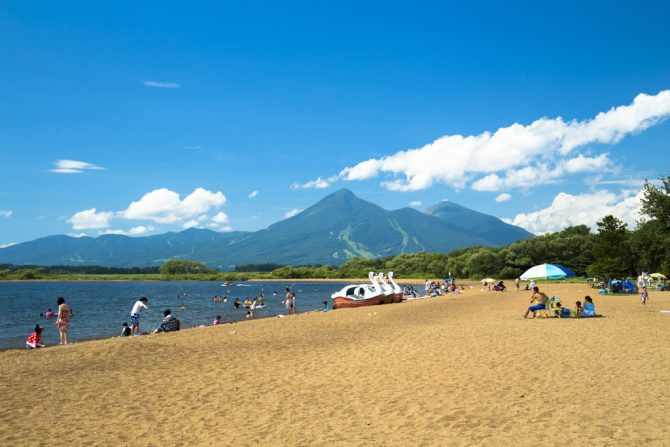
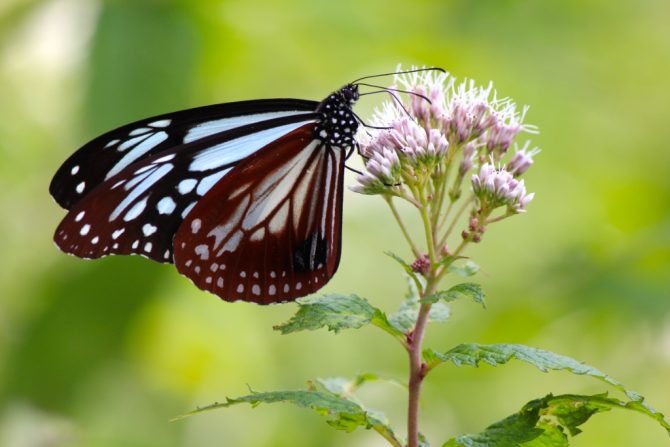
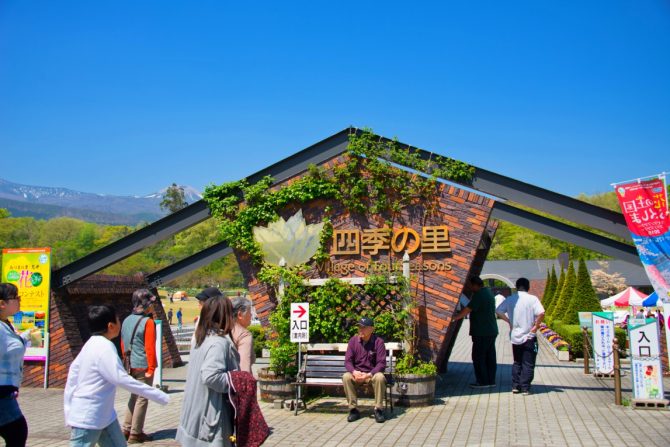
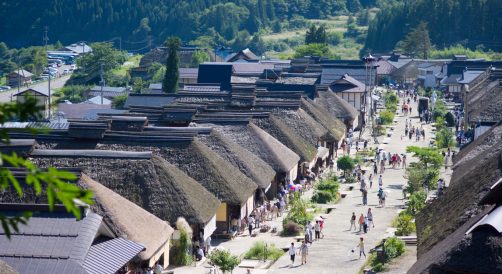
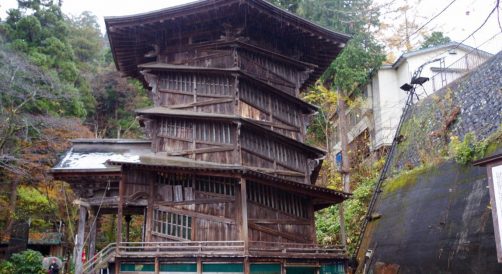
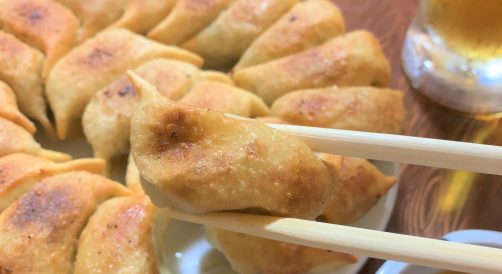
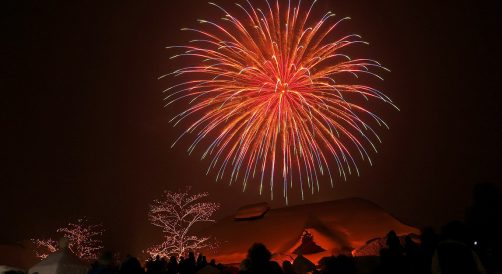
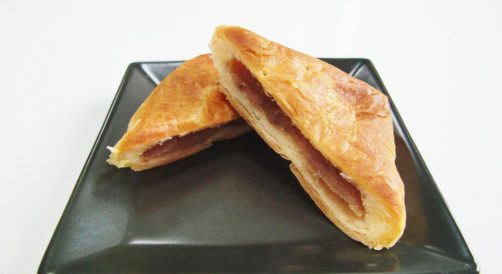
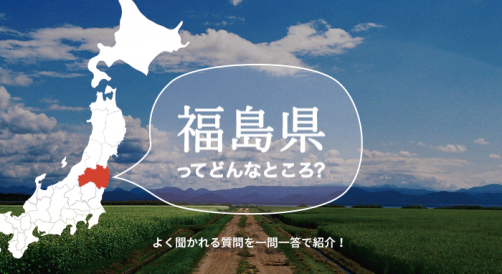
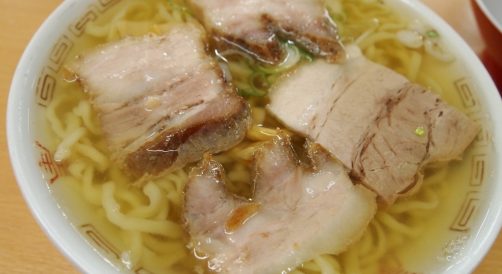
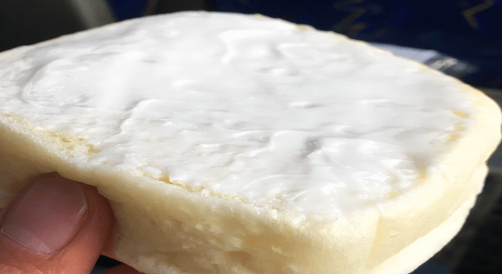
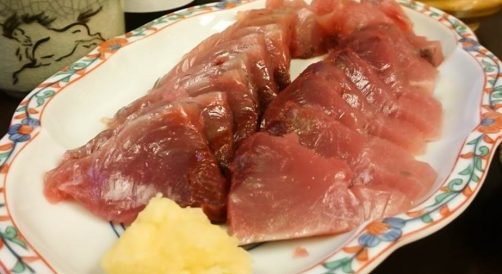
 ページトップへ
ページトップへ




